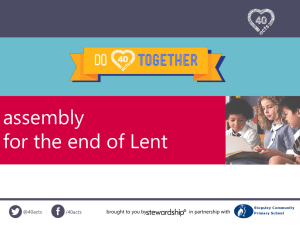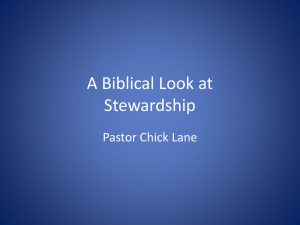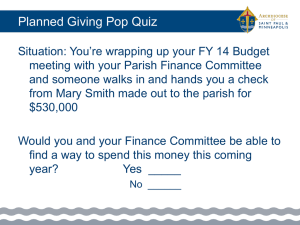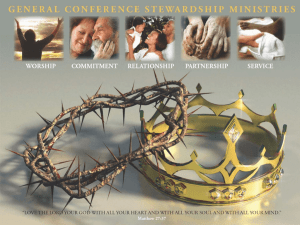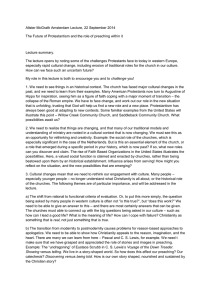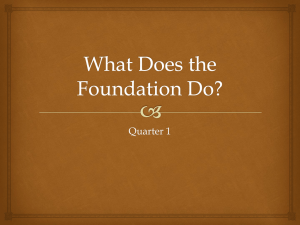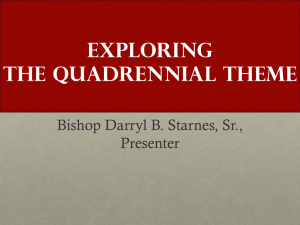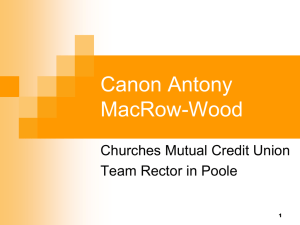¹ - Stewardship Calling
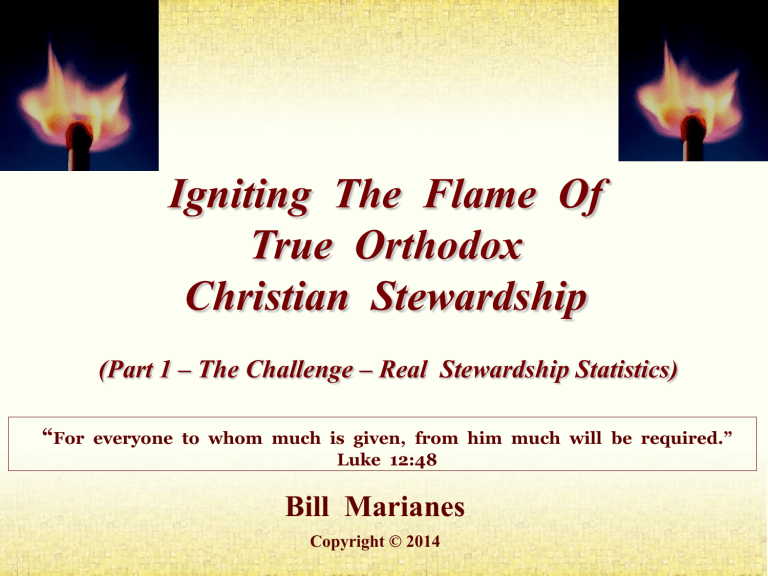
Igniting The Flame Of
True Orthodox
Christian Stewardship
(Part 1 – The Challenge – Real Stewardship Statistics)
“ For everyone to whom much is given, from him much will be required.”
Luke 12:48
Bill Marianes
Copyright © 2014
Part 1
The Challenge -
Real Stewardship
Statistics
The Challenge
• We have a SIN challenge
~ S pirituality challenge
~ I ncome challenge
~ N umbers challenge
• The root cause of many Parish challenges is a actually stewardship problem
(i.e., people neither understand nor practice true stewardship of our time, talents, treasures and tithes)
We Have an
Unemployment and
Underemployment Challenge
The 2 Biggest Parish
Challenges
1. Unemployment - the “parishioners” who are not involved in any ministries or services
2. Underemployment - the parishioners who are not as actively engaged in ministries and services as they could be
Spirituality, Income
Numbers Stewardship and Demographic
Statistics ¹
¹ This next module includes some financial stewardship and related economic and demographic information, and does not exclusively deal with the more important spiritual aspects of our stewardship ministry. As such, some business and fundraising terms will be used with no desire to demean the more significant spiritual and service stewardship objectives we should pursue.
Selected “ S pirituality”
Challenge Facts
Thought-Provoking Question
• You get what you measure!
• You are measuring your financial stewardship results.
• How are you measuring if you are improving the spirituality and engagement of your parishioners?
Laity Spirituality Challenges
“Despite having more born-again Christians today than 10 years ago, America is spiritually stagnant” ¹
¹ State of the Church report by the Barna Research Group (BRG) from a nationwide study of the country's faith practices and perspectives
Laity Spirituality Challenges¹
• “Regular Bible reading dropped over the last decade from 45% to 37%.
• Volunteering at church declined from 27% to 20% over the same decade.
• Church attendance has slipped from 49% to
42% percent.
• 40% of Christians do not attend church or read the Bible in a typical week
• 70% of Christians are not involved in a small group that meets for spiritual purposes
• There are more than 10 million Christians who are un-churched
”
¹ State of the Church report by the Barna Research Group (BRG) from a nationwide study of the country's faith practices and perspectives
Gallup Church
Spirituality Studies
Where You Live Matters
The Importance of Religion
Factors in the Downward Slide in Mainline Churches¹
1.
“Any church that places few demands on its congregants, and does not pay attention to the ultimate questions of faith, will find itself on the sidelines.”
2.
“Another factor in the decline was the lack of emphasis on evangelism or invitation among mainline churches, in contrast to evangelical churches.”
¹ In Vanishing Boundaries: The Religion of Mainline Protestant Baby
Boomers, by Dean R. Hoge, Benton Johnson, and Donald Luidens
Factors in the Downward Slide in Mainline Churches¹
• The level of "engagement" among congregations is of key importance.
• The role of engagement within congregations has very little to do with theology or doctrine, but has a great deal to do with the interactive engagement level of members.
¹ Al Winseman, Gallup's Global Practice Leader in Faith Communities
Factors in the Downward Slide in Mainline Churches¹
“From all of the data the following steps are important if a particular denomination seeks to experience growth in the depth and breadth of its followers in the years ahead:
1. Focus on ultimate questions of faith
2. Place certain demands on congregants and "engage" them
3. Build youth programs
4. Stress a program of evangelism and invitation”
¹ Results of a nationwide US survey throughout 2002 conducted by the Gallup organization
The Youth Challenge Facts
The “millennial generation” (born after 1980) is “less religiously affiliated” than any previous generation.
One in four Americans aged 18-29 do not affiliate with any particular religious group.
Millennials are twice as unaffiliated as Baby Boomers (born between 1946 and 1964) were at the same age.
¹
Religion in the Millennial Generation (2010) and U.S. Religious Landscape Survey (2007), Pew Forum on Religion &
Public Life of the Pew Research Center.
Young People Dis-affiliation
The Big 4 Youth
Questions/Challenges
1. Are there any colleges or universities in this area?
2. Do any Orthodox students from outside this area attend any of these colleges or universities?
3. Do you know all of them?
4. What are you going to do about it?
Clergy Training Challenges
• “Clergy in America have not been sufficiently trained as CEO’s of institutions to be comfortable and conversant with contemporary fundraising technology and techniques.”¹
• US clergy study: “77% of U.S. Clergy are very or extremely satisfied with their seminary training on theological and liturgical issues, but a mere
7% are similarly satisfied with their training on financial duties.” ²
• 85% of clergy are not trained in the theory of stewardship and had no books on Christian stewardship in their libraries³
¹Robert Evans, of Giving USA’s editorial review board
²“Clergy As Reluctant Stewards of Congregational Resources”
, Daniel Conway, 1999;
“Financing American Religion”
³Christian Stewardship Association; Barna Research Group; Empty Tomb; Giving USA Foundation
Selected “ I ncome”
Financial Stewardship
Challenge Facts
Church Giving Decreases in 2011¹
• Individual charitable donations rose nearly 4% in 2011
• Individual donations to churches and religious bodies dropped by 1.7% -- a decrease for the
2 nd year in a row.
¹Giving USA report, compiled by the Indiana University Center on
Philanthropy and released Tuesday (June 19)
Church Giving Decreases in 2011¹
• “The proportion of the charitable donations going to religious groups has been falling steadily for decades.”
• The reasons for the decline include:
(1) increased competition from a proliferating number of non-religious organizations;
(2) a decrease in church attendance;
(3) a general lack of sophistication within religious institutions regarding fundraising.”
¹Robert Evans, of Giving USA’s editorial review board
Charitable Giving Facts
•
People are giving a lower percent of income to churches in the 2000’s then they did either during the Great
Depression or the 1920’s
•
The number of nonprofit 501(c)(3)s soliciting volunteers and funds almost doubled, but the number of U.S. churches remained the same
•
In 1985, religious entities received
53% of charitable donations but by 2007 churches received only 33% of charitable donations
¹ Christian Stewardship Association; Barna Research Group; Empty Tomb; Giving USA Foundation
Charitable Giving Facts
1.
“Nearly all the parishioners we interviewed said that they in fact could give more than they do and believe that
they should give more.” ¹
(i.e., our parishioners can, and do want to, give more)
2.
“The number one reason that both pastors and parishioners cited as the major barrier to Christian generosity is the individualistic, consumerist nature of
American society.” ¹ (i.e., our “Burger King” mentality is a detriment)
3.
The annual value of charitable gifts from those who attend church weekly is $2,210 versus only $642 for who only attend a few times or have no religion.
(i.e., getting our parishioners engaged in church also helps our fundraising)³
1 Passing the Plate
– Why American Christians Don’t Give Away More Money, Christian Smith, Michael O. Emerson with
Patricia Snell
2
“Clergy As Reluctant Stewards of Congregational Resources”
, Daniel Conway, 1999;
“Financing American Religion”
, Walnut
Creek, CA: AltaMira
3 Who Really Cares -
America’s Charity Divide Who Gives, Who Doesn’t, and Why It Matters, Arthur C. Brooks
The Facts
Based on nation-wide US church stewardship research¹:
• 90% of churches have no stewardship plan
• On average Americans spend:
- 50 hours per week working
- 12 hour per week watching TV
- 1 hour per week on religious or volunteer activities
• 37% of church goers give $0 to the church
¹ Christian Stewardship Association; Barna Research Group; Empty Tomb; Giving USA Foundation
Charitable Giving Facts
1. Historically, recessions have little effect on religious giving. ¹
2. “…congregations with fewer committees are the most likely to struggle finding people to serve… regardless of size.”²
¹ See: (a) Giving During Recessions and Economic Slowdowns” written and researched by the Center on Philanthropy and available from the Giving USA Foundation: (b) “Weathering an Uncertain Economy”, in “Philanthropy Matters,” The Center on Philanthropy at Indiana University, Volume, 16, Issue 2, 2008, p. 5. (c) “Giving USA Spotlight”, Issue 3, 2008, p. 1; (d)
Independent Sector, “Giving in Tough Times: The Impact of Personal Economic Concerns on Giving and Volunteering.”
2003.
² American Congregations 2008 Study - “Fact 2008 Study” - Cooperative Congregational Studies Partnership (14,301 places of worship surveyed)
General Statistical
Averages ¹
•
INCOME TOTALS
Stewardship = 52%
• Disguised Stewardship = 20%
• NO (Non-Orthodox) Income = 28%
EXPENSE TOTALS
• Personnel + Office = 52%
• Occupancy
• Other
= 30%
= 18%
82%
¹ This is a compiled statistical average from many different parishes of different sizes from many different
Metropolises and areas. This sample is constantly being updated, but the percentages are not changing materially, except for slight decreases in Stewardship and slight increases in Non-Orthodox income.
Charitable Giving Facts
1. Total 2010 reported income from all U.S. Greek
Orthodox Archdiocese parishes was $230,654,324
2. On average, less than 52% of our church income comes from stewardship. Our 550+ Parishes generated approximately $119,940,248 from stewardship
3. Depending on how many stewards we have¹, our average per steward per year contribution is:
$ 80 (assuming 1.5M individual parishioners);
$120 (assuming 1M individual parishioners); or
$218 (assuming 0.55M individual parishioners).
¹ The Archdiocese previously reported total church membership of 1,500,000 parishioners. Recently, the
Archdiocese Council was told the number might be closer to 1,000,000, while an independent researcher recently concluded that in 2009 there were only 550,000 U.S. Greek Orthodox Christians.
Greek Orthodox Archdiocese and U.S. Christian Charitable
Giving Statistics¹
$ %
Best case 2010 stewardship of
Greek Orthodox
Archdiocese Parishioners average =
U.S. Christian average =
U.S. Evangelical Protestant average =
$218 --
$880 +403%
$1,165 +534%
¹ All numbers are per person - per year direct financial stewardship contributions
That Was Then - This Is Now
Education
THEN
(Yiayia and Papou)
Limited / informal
Income
Average Tray
Contribution
Budget % from
Non-Parishioners
(laborers/merchants)
$1
0%
* $1 in 1922 = $13.70 in 2012 due to inflation
$1 in 1960 = $ 7.52 in 2012 due to inflation
NOW
(Us)
4th highest in
U.S.
3 rd highest in
U.S.
$1 *
28%
Selected “
N
umbers”
Challenge Facts
Pew Forum U.S. Religious
Landscape Survey
• … constant movement characterizes the
American religious marketplace, as every major religious group is simultaneously gaining and losing adherents .
•
Religion in the United States is often described as a vibrant marketplace where individuals pick and choose religions that meet their needs, and religious groups are compelled to compete for members .
The Latest Church
Growth Statistics¹
• “Overall, total U.S. church membership declined by 1.05% over 2010 to
145,838,339 members.”
•
"The direction of membership (increases or decreases) remains very stable.” (i.e., churches which have been growing in recent years continue to grow, and churches declining in recent years continue to decline.)
¹ National Council of Churches'
2011 Yearbook of American & Canadian Churches
Major Denominations
That Are Declining
“Top 25” Denominations Reporting
2010-11 Membership Decreases
2. Southern Baptist Convention (16,160,088 members) down 0.42%.
3. The United Methodist Church (7,774,931 members) down 1.01%
7. Evangelical Lutheran Church in America (4,542,868 members) down 1.96%
10. Presbyterian Church (U.S.A.) (2,770,730 members) down 2.61%
13. The Lutheran Church – Missouri Synod (2,312,111 members) down 1.08 %
14. The Episcopal Church (2,006,343 members) down 2.48 %
19. American Baptist Churches in the U.S.A. (1,310,505 members) down 1.55%
21. United Church of Christ (1,080,199 members) down 2.83%
¹ National Council of Churches' 2011 Yearbook of American & Canadian Churches
But Some Major Denominations
Are Increasing
“Top 25” Denominations Reporting
2010-11 Membership Increases
1. The Catholic Church (68,503,456 members) up 0.57%
4. The Church of Jesus Christ of Latter-day Saints (Mormon Church)
(6,058,907 members) up 1.42%
9. Assemblies of God (2,914,669 members) up 0.52%
20. Jehovah’s Witnesses (1,162,686 members) up 4.37%
22. Church of God (Cleveland, TN.) (1,076,254 members) up 0.38%
24. Seventh-Day Adventist Church (1,043,606 members) up 4.31%
¹ National Council of Churches' 2011 Yearbook of American & Canadian Churches
How Is the GOA Doing?
GOA Baptisms Are Declining
GOA Chrismations Are Declining
GOA Weddings Are Declining
And Finally, Something That is
Sometimes Growing
(kinda sorta)...
The Bottom Line
• Church membership is declining
• Church sacraments are declining
• Church contributions are declining
• Church member spirituality is declining
• Church relevance is declining
• Church stewardship is declining
• Church disengagement by youth is increasing
• Church member deaths are increasing
• Church dependence on Festivals is increasing
Now What Ollie?
The Solution
The Solution

